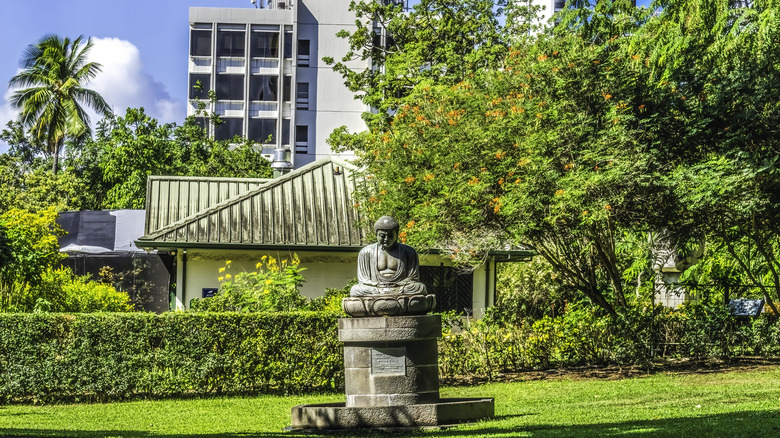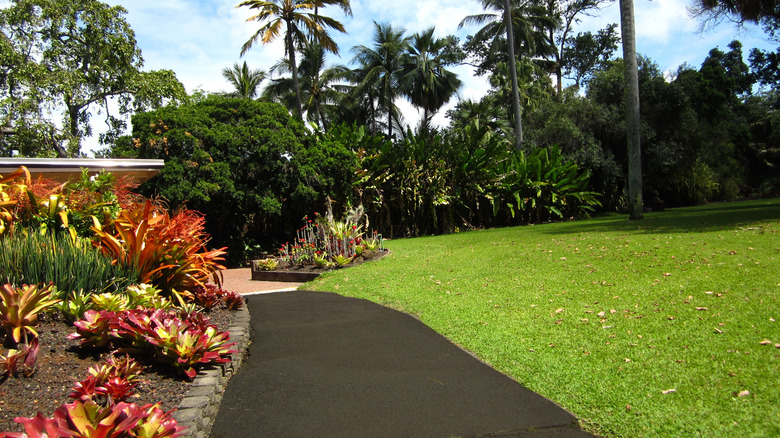Hawaii's Oldest Botanical Garden Is A Wildly Underrated Gem Hidden In The Heart Of Honolulu
There is something deeply calming about being surrounded by greenery. Studies show that green spaces can reduce the risk of anxiety and depression, lower blood pressure, and boost overall well-being. And when it comes to lush landscapes, few American destinations rival Hawaii. Tucked away in the heart of the state's busiest, largest, and capital city, Honolulu's Foster Botanical Garden proves this point beautifully. Surprisingly under the radar, especially compared to the island's famous beaches and hikes, Foster Botanical Garden, along with the nearby Lyon Arboretum, are among the lesser-known Hawaiian destinations. Spread over 14 enchanting acres, some of the gardens' oldest trees, including towering palms and rare prehistoric cycads, were planted in the 1850s. Today, the garden is home to over 4,000 plant species, most of which are endemic to the tropical region.
It's a family-friendly attraction, rarely crowded, and always a good option for a day outdoors away from the beach. As one visitor noted, "We were particularly captivated by the garden's ancient trees, some of which date back to the 1850s. The towering quipo tree and the unique cannonball tree were among our favorites. The Butterfly Garden was a highlight for our children. Navigating the arboretum was easy with the self-guided tour maps provided at the entrance. The pathways are well-maintained and mostly stroller-friendly, making it convenient for families."
While Honolulu might have a rep for being crowded and overrated, it's also the only U.S. city among the ranks of the cleanest in the world. Clean air and unpolluted land, along with its tropical climate and rich volcanic soil, create the perfect conditions to make Hawaii, and Honolulu in particular, a gardener's paradise.
A short history of the Foster Botanical Garden, the oldest garden in Hawaii
The roots of the garden lie in a modest plot of land that was leased by Queen Kalama to a German physician with a passion for plants back in 1853. That physician went on to become a pioneer botanist of the state. Decades later, the land was sold to Mary Foster, an influential feminist, philanthropist, and one of the "first modern Buddhists." When she died in 1930, the arboretum was left to the City of Honolulu and opened to the public one year later. More than 10,000 trees and plants were planted across the gardens' 13.5 acres over the next few decades.
It's no coincidence that this unique collection of plants thrives here. According to the official Gardens of Hawaii website, "Almost any type of plant can grow in the state of Hawaii." Thanks to its volcanic soil, humid climate, and monsoon rainfall, the islands house more than 2,600 endemic plants — flora that can only be naturally found in this region. With this, the islands have some of the highest rates of endemism in the world. Unfortunately, according to the Center for Plant Conservation, around 30% of Hawaii's flora is in danger of extinction, and 10% has already gone extinct.
This fragile ecosystem helped spark a landmark conservation move known as the Exceptional Tree Act. In 1975, after a wave of urbanization and construction in Honolulu, Hawaii passed a law recognizing the responsibility to protect trees noted for their physical beauty, age, size, and ecological importance. The Foster Botanical Garden is home to 25 of these Exceptional Trees, including a rare palm, a baobab tree, and a bodhi tree.
The Foster Botanical Garden is a respite of calm and beauty in the middle of Hawaii's biggest city
Even if you don't know the difference between a fern and an orchid, gardens and parks have a magical way of bringing a sense of peace and tranquility to the world's biggest cities. The Foster Botanical Garden is home to a 200-foot-high quipo tree that has been standing since 1933. Even older than this is a bodhi tree that was gifted to the founder and namesake, Mary Foster, as part of the first cutting of the sacred Bodhi tree in 1913. The park is made up of six main zones, including a Conservatory, a Prehistoric Glen home to species that date back 250 million years, and an Economic Garden with a variety of herbs, medicinal spices, and poisonous plants.
Not only is the garden impressive in terms of tropical biodiversity, but also for its accessibility. The admissions fee for tourists is $5, while Hawaiian residents get a $2 discount. There's even an annual family pass, which allows unlimited access for just $25. Once inside, free guided tours start at 10:30 a.m. on Mondays, Wednesdays, Fridays, and Saturdays. Tours last an hour and a half and are guided by an expert passionate about the garden's history and plants.
Foster Botanical Garden is located at 180 North Vineyard Boulevard in Honolulu, just 5.4 miles, or a 30-minute bus ride, from the Daniel K. Inouye International Airport. It's open year-round from 9 a.m. to 4 p.m. except for Christmas and New Year's Day. As for how long a trip here typically lasts, John G mentions, "This is a 'pocket' botanical garden that you can visit in about one hour."


